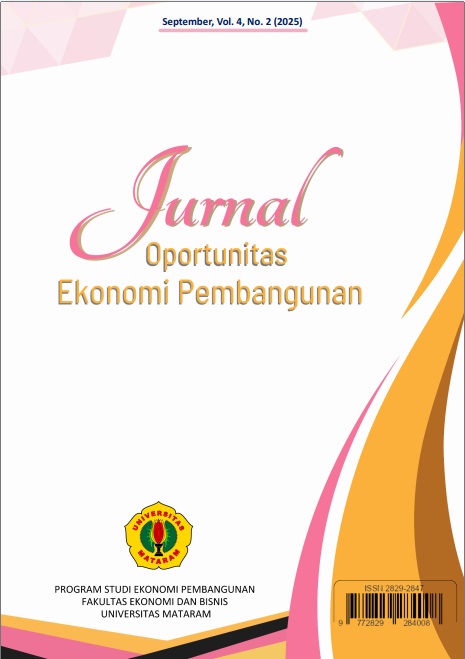POVERTY REDUCTION STRATEGY IN MADURA: A PANEL DATA REGRESSION ANALYSIS
DOI:
https://doi.org/10.29303/oportunitas.v4i2.2501Keywords:
Gross Regional Domestic Product, Economic Growth, Human Development Index, PovertyAbstract
This research aims to evaluate the influence of gross regional domestic product, economic growth, and human development index on poverty levels in four Madura districts: Bangkalan, Sampang, Pamekasan, and Sumenep. We analyze secondary data, including annual data from 2014-2023, using the panel data regression method. The research results show that gross regional domestic product has a significant positive influence on poverty levels, indicating that increasing economic activity can increase poverty due to potential inequality in economic distribution. Conversely, research demonstrates a significant negative impact of economic growth and the human development index on poverty levels. This means that increasing economic growth and human development can effectively reduce the level of poverty in Madura. The policy implications necessitate the implementation of more inclusive strategies to promote equitable distribution of economic benefits throughout the region and underscore the significance of investing in human development to enhance the quality of life and economic prospects of Madurese individuals.
References
Dornbusch, R., Fischer, S., & Startz, R. (2008). Macroeconomics (10th ed.). McGraw Hill International Edition.
Erlando, A., Riyanto, F. D., & Masakazu, S. (2020). Financial inclusion, economic growth, and poverty alleviation: evidence from eastern Indonesia. Heliyon, 6(10), e05235. https://doi.org/10.1016/j.heliyon.2020.e05235
Hasibuan, L. S. (2023). Analisis Pengaruh Ipm, Inflasi, Pertumbuhan Ekonomi Terhadap Pengangguran Dan Kemiskinan Di Indonesia. Jurnal Penelitian Pendidikan Sosial Humaniora, 8(1), 53–62. https://jurnal-lp2m.umnaw.ac.id/index.php/JP2SH/article/view/2075/1261
Hernawati, I. (2017). Pengukuran konstrak kemiskinan di Indonesia The measurement of poverty construct in Indonesia. Media Informasi Penelitian Kesejahteraan Sosial, 41(3), 269–284.
Iqbal Salsabil, & Westi Rianti. (2023). Pengaruh Pertumbuhan Ekonomi, Tingkat Pendidikan, Tingkat Kesehatan dan Laju Pertumbuhan Penduduk terhadap Tingkat Kemiskinan di Provinsi Jawa Barat pada Tahun 2016 – 2020. Jurnal Riset Ilmu Ekonomi Dan Bisnis, 15–24. https://doi.org/10.29313/jrieb.v3i1.1886
Lavenia, L., Mandai, S., & Muhammad Yudhi Lutfi. (2023). Pengaruh Produk Domestik Regional Bruto (Pdrb), Upah Minimum, Pengangguran, Jumlah Penduduk Dan Angka Melek Huruf Terhadap Kemiskinan Di Provinsi Jawa Barat Tahun 2015 - 2021. Jurnal Ekonomi Trisakti, 3(1), 319–328. https://doi.org/10.25105/jet.v3i1.15412
Leonita, L., & Kurnia Sari, R. (2019). Pengaruh PDRB, Pengangguran Dan Pembangunan Manusia Terhadap Kemiskinan Di Indonesia. ISOQUANT: Jurnal Ekonomi, Manajemen Dan Akuntansi, 3(2), 1–8. https://doi.org/10.24269/iso.v3i2.252
Li, X., & Zhou, Y. (2024). Targeted poverty alleviation promotes sustainable socio-economic and ecological development in China’s poor areas. Geography and Sustainability. https://doi.org/10.1016/j.geosus.2024.04.007
Mamun, M. A., & Ullah, I. (2020). COVID-19 suicides in Pakistan, dying off not COVID-19 fear but poverty? – The forthcoming economic challenges for a developing country. Brain, Behavior, and Immunity, 87(May), 163–166. https://doi.org/10.1016/j.bbi.2020.05.028
Ranis, G., Stewart, F., & Samman, E. (2006). Human Development: Beyond the Human Development Index. Journal of Human Development, 7(3), 323–358. https://doi.org/10.1080/14649880600815917
Todaro, M. P., & Smith, S. C. (2012). Economic Development (11th ed.). Addison-Wesley.
Yubilianto. (2020). Return to education and financial value of investment in higher education in Indonesia. Journal of Economic Structures, 9(1). https://doi.org/10.1186/s40008-020-00193-6
Downloads
Published
Issue
Section
License
Copyright (c) 2025 Rahmat Zulkarnain, Muhlisin Muhlisin, Nurul Hidayat, Edi Awan

This work is licensed under a Creative Commons Attribution-ShareAlike 4.0 International License.








